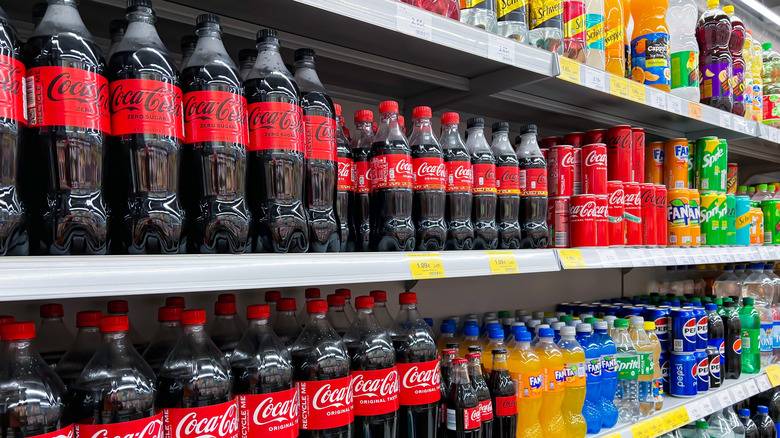The Reason Coca-Cola Changed From Glass To Plastic Bottles
Coca-Cola is among the globe's most well-known brands, a status achieved by not only the drink itself, but packaging, too. First bottled in 1899, the soda's distinct look formed over decades of evolution, with a general aim of immediate recognition. The earliest version of its signature contour shape glass bottle was released in 1916 (prior versions are now often rare antique collectibles). Then Coca-Cola sold the world's first six-pack in 1923, and in 1960, debuted its soda — in cans. Furthermore, in January of 1993, came another momentous release: The 20-ounce Coca-Cola bottled in plastic (it had been supplying two-liters in plastic since 1978).
Although now so commonplace, the debut initially faced backlash, with both soda rivals and the press skeptical regarding the changeup. Yet savvy Coca-Cola executives backed the redesign with several reasons, subsequently cementing the package as a commercial success. For one, there's the plastic container's large 20-ounce capacity, several times larger than a 6.5-ounce glass bottle. The size encouraged consumers to drink more Coca-Cola at once; the largest fountain container was capped at 16 ounces previously. Meanwhile, the product could sell standalone, making it an easy everyday purchase. All such factors added up to higher profits than other packaging options — and sales immediately increased, too, partly thanks to both novelty and nostalgia. Still all contained in the quintessential contour design, the plastic container defined a new Coca-Cola era.
Coca-Cola's shift from glass to plastic has generated environmental concerns
The 20-ounce bottle continues to sell today, but it wasn't Coca-Cola's first plastic foray. Some 18 years prior in 1975, the brand tested a 32-ounce plastic model; an innovative container intended for improved distribution and — according to Coca Cola management — a better environmental footprint. Such ambitions didn't prove fruitful, as the company's first plastic containers were made from acrylonitrile, a material the FDA banned in 1977.
For the 1993 release, Coca-Cola shifted to a PET plastic composition, which still serves as the most commonplace industry standard. Opposed to clunky glass bottles, such a material comes with many convenient features. The original, now out of production in the U.S., 6.5-ounce glass size sold alongside a deposit, urging consumers to return the container. However, easier-to-transport plastic is not only cheap to manufacture, but can simply be tossed after use. Like with water bottles, the material isn't meant for refilling, and instead generates copious waste — making Coca-Cola a sizable contributor to worldwide pollution — single-use plastics in general are one of the largest polluters across the world.
PET bottles can be recycled, and Coca-Cola has expanded its initiatives to make its plastic more environmentally friendly. Furthermore, some global regions are bringing back deposit schemes for plastic materials, too. Nevertheless, ardent supporters still hope for a full-fledged return to reusable Coca-Cola packaging. Plus, you can still find glass bottles in circulation — often referred to as Mexican Coke in the U.S. Nevertheless, from 1993 onward, Coca-Cola continues to promote a convenient and cost-effective plastic composition as the standard.


